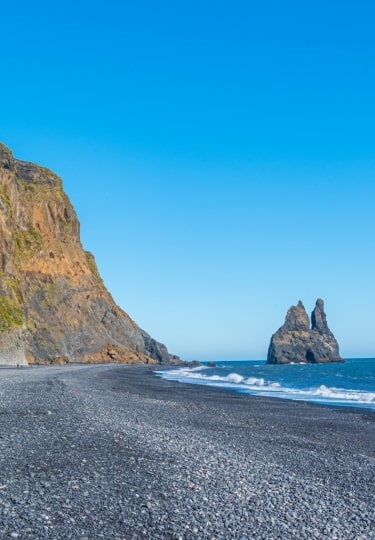Iceland’s beaches are dramatic and otherworldly. The island—similar in size to the state of Kentucky—is encircled by an 828-mile ring road, making it possible to access many of Iceland’s isolated beaches, even if you’re more likely to be there for the bracing fresh air than for tanning and sunbathing.
From sweeping golden shores to hidden coves and black-sand strips, the best beaches in Iceland have one thing in common: they all offer wild seascapes.
Whether on a day trip from the capital, Reykjavík, or visiting the northern fjord regions, set expectations high when visiting Iceland beaches and you won’t be disappointed.
Explore the 15 best beaches in Iceland below.
Djúpalónssandur Beach

Djúpalónssandur Beach
On the western tip of Iceland, this curved volcanic beach made up of sand and stones clings to the Snæfellsnes Peninsula.
To reach Djúpalónssandur, follow the path from the highway that cuts through a lava field punctuated with jagged lava formations.

Vatnshellir Cave
Before turning off for the beach, stop by Vatnshellir Cave, an 8,000-year-old lava tube that was the result of a landscape-altering volcanic eruption. Guides offer fascinating tours of Vatnshellir via a spiral staircase leading down into the 114-foot cave.
On the beach, witness the shell of an English trawler, Epine GY 7, which was shipwrecked here in 1948. Sadly, 14 lives were lost.
There are some spectacular coastal viewing points to stop at near Djúpalónssandur, too, including the fishing villages of Hellnar and Arnarstapi, and the soaring cliffs of Lóndrangar.

Djúpalónssandur Beach
Wrap up in layers when exploring sections of Iceland’s coastline—you might be surprised by a mild summer’s day, or you might encounter the wild west, with mist, wind, and rain rolling off the ocean.
Ytri-Tunga Beach
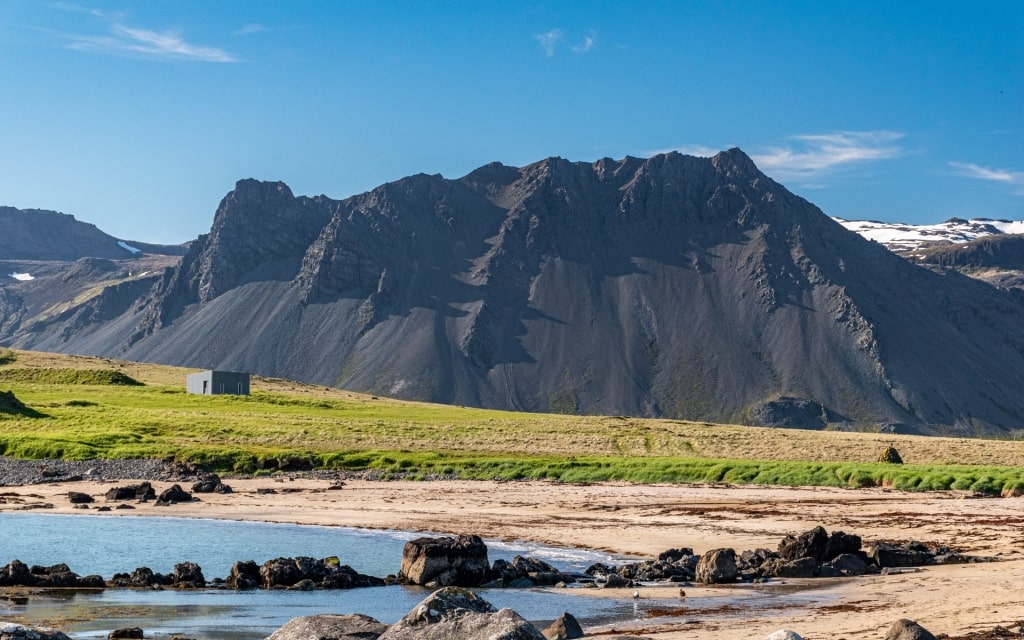
Ytri-Tunga Beach
Chalk off the gorgeous Ytri-Tunga Beach on the Snæfellsnes Peninsula, a two-hour drive north of Reykjavík along Iceland’s craggy coastline.
While most Iceland beaches possess black sand, dreamy Ytri-Tunga is a standout for its golden shoreline.
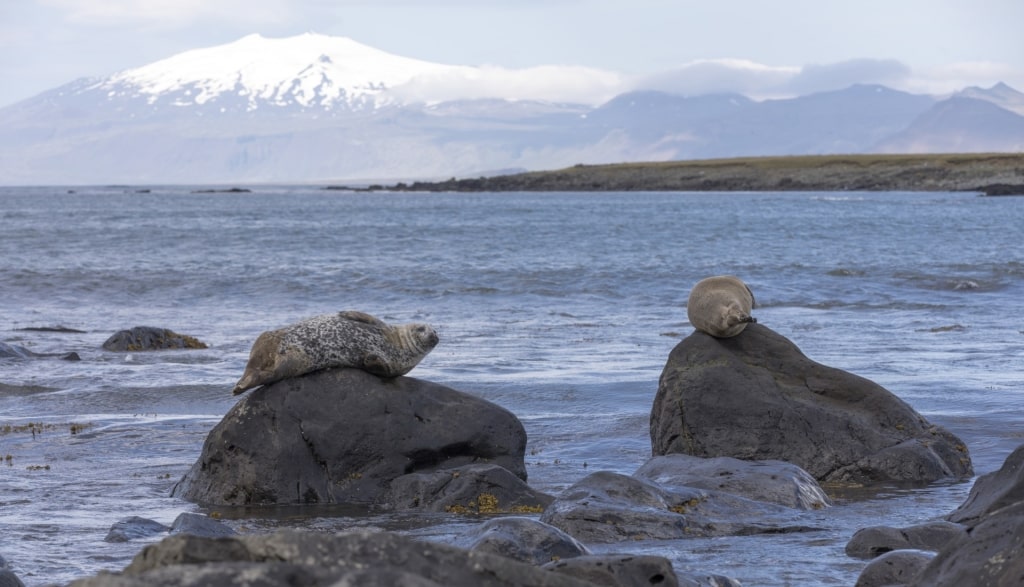
Ytri-Tunga Beach
Visiting here is one of the best things to do in Iceland, with travelers often greeted with the sight of harbor and gray seals, especially during summer when they can be spotted perched on the rocky shore. Pack your camera to capture these beautiful marine creatures, but remember to keep a safe distance—around 165 feet is recommended.
Ólafsfjörður Beach, near Akureyri

Ólafsfjörður Lake
On the north coast of Iceland, Ólafsfjörður’s glorious black-sand beach lies at the mouth of the Eyjafjörður fjord, surrounded by snowy peaks. During summer in Iceland, winter’s snow slowly melts, creating tumbling waterfalls all around.
The beach faces Ólafsfjörður town, a fishing settlement dotted with colorful timber houses, backed by the trout-filled Ólafsfjörður lake.
Enjoy a shoreline hike to soak up the captivating scenery. This wide-open beach feels completely remote. Even though the small town is a short 15-minute walk away, you may find you have the beach entirely to yourself.
Reynisfjara Beach
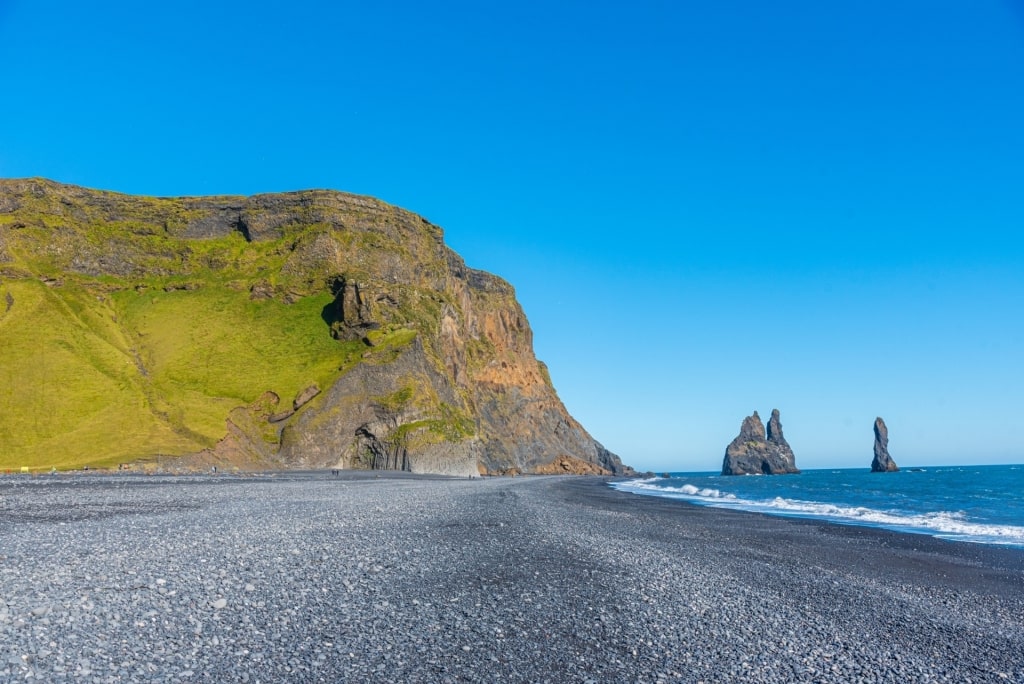
Reynisfjara Beach
One of the best places to visit in Iceland, this extraordinary south coast beach is worth every second of the two-and-a-half hour journey from Reykjavik.
As far as black shores go, Reynisfjara is one of the best beaches in Iceland, with pounding Atlantic waves and craggy rock formations adding to the drama.
Like many of the island’s beaches, Reynisfjara isn’t suitable for swimming or bathing, but there’s still plenty to do here.

Hálsanefshellir Cave
Order a coffee from Black Beach Restaurant, right by the beach, and walk the short distance to Hálsanefshellir Cave, on the shore. Lying at the base of Reynisfjall mountain on the easternmost point of Reynisfjara, Hálsanefshellir is a staggering sea cave featuring a wall of soaring basalt columns.

Vik í Myrdal
On a visit to Reynisfjara, stop by Vik í Myrdal, a storybook village that’s the most southerly on mainland Iceland.
A pretty white church gleams from a hilltop and a number of cafés and restaurants are dotted around, including a pizzeria, craft beer venue, and the upmarket Icelandic restaurant, Berg.
Dyrholaey Beach
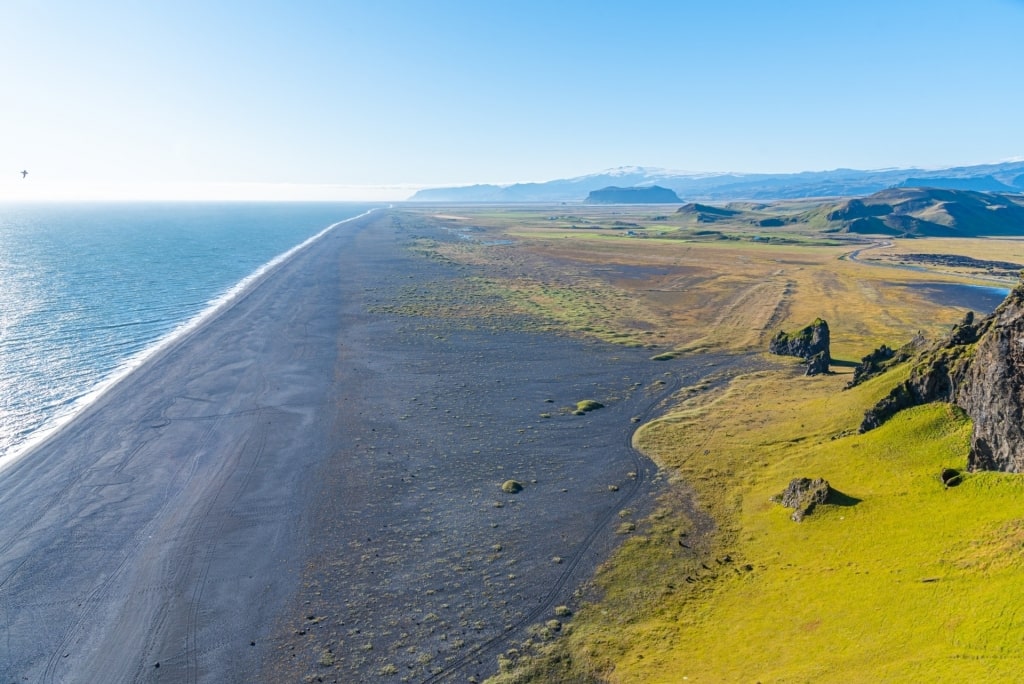
Dyrholaey Beach
To the west of Reynisfjara, Dyrholaey makes the list of the best beaches in Iceland because it unfolds for miles along the south’s unspoiled coastline.
Dyrhólaey, also known as the Endless Black Beach, features the white-cubed Dyrhólaeyjarviti lighthouse, warning passing vessels of the serrated sea stacks just off the shore.
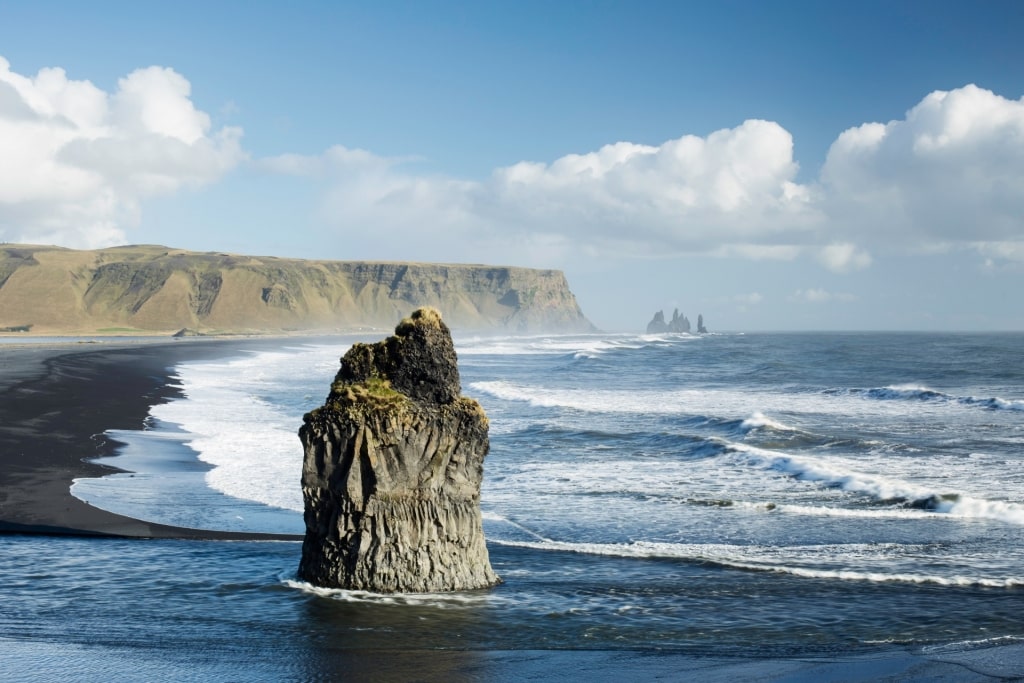
Dyrholaey Beach
This volcanic beach is known for its tremendous arch, the result of coastal erosion. It’s so big that a pilot famously flew a small aircraft through in 1993.
Dyrhólaey is a nature-lovers dream, with year-round eider ducks and migratory Atlantic puffins nesting between May to September.

Skógafoss
Tag on a visit to the nearby Skógafoss, a thundering Icelandic waterfall with a drop of around 200 feet, a short distance away.
Búðir Beach

Búðir Beach
Búðir Beach is a sweep of blond sand facing Faxaflói Bay on the edge of the vast Búðahraun lava field in west Iceland.
The lava flowed here around 5,000 to 8,000 years ago from Búðaklettur volcanic crater, which is central to the lava field.
The beach has been a designated nature reserve since 1977. Wander among the beautiful swathes of wildflowers that grow here during summer. Travelers can also visit Búðahellir, a cave that unfurls 1,253 feet into the crater.
Enjoy a windswept walk on the beach. The black lava rocks scattered across the shore offer another reminder of Iceland’s volatile geology.

Búðakirkja
Take in the attractive Búðakirkja, a 19th-century, jet-black church next to the beach, and the nearby horsetail-shaped Bjarnarfoss. The tumbling water can be seen from the road behind the beach. If you’ve time to spare, visit the waterfall’s viewing platform for a closer look.
Álftanes Beach, near Reykjavik

Álftanes Beach, near Reykjavik
One of the closest beaches to Iceland’s capital, Álftanes lies just 20 minutes south of Reykjavik, nestled on the stirring Reykjanes peninsula.
Surrounded by rolling green fields, Álftanes lies close to Bessastaðir and Bessastaðakirkja, the official residence of the President of Iceland and a pristine white church, respectively.

Bessastaðakirkja
Bessastaðir is handsome and historic in equal measure. A former farmstead of Snorri Sturluson, Iceland’s celebrated 13th-century scholar, and the King of Norway, following Sturluson’s assassination, it’s been the home of Icelandic democracy since the 1940s.
Pick up a coffee from the town’s cozy Álftanes cafe, which also serves delicious homemade soups, plump sourdough loaves, and indulgent cakes.
Álftanes Beach hits the mark for hikers, with plenty of trails lacing the headland. Grapple with a hike around Gálgahraun, a large lava field where excavations have revealed that executions likely took place here during Iceland’s settlement period (around 870–930).
Nautholsvik Beach, Reykjavik
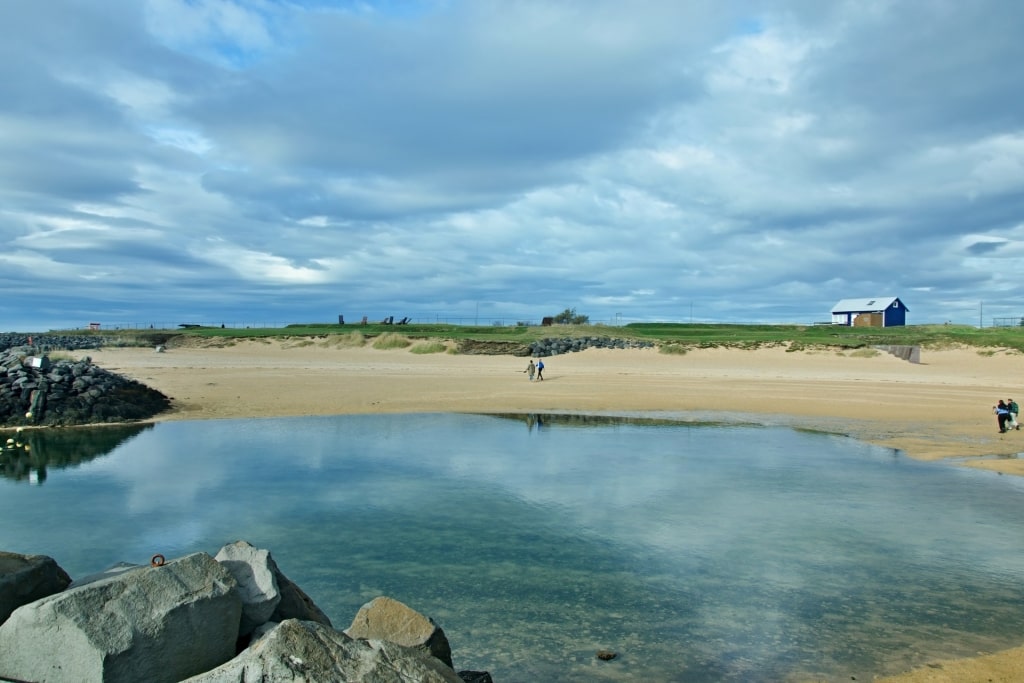
Nautholsvik Beach, Reykjavik
Nautholsvik stands apart as one of the best beaches in Iceland for its central location and the opportunity it offers visitors to plunge into the refreshing water.
As beautiful as Iceland’s beaches are, not many are suitable for swimming. Nauthólsvík is an exception thanks to a lagoon created by a sea wall built in 2001, with hot water pumped into the pool, creating temperatures of 15°-19°C/59°-66°F during summer.
Enjoy a leisurely swim and lounge on the crescent shore. There are hot tubs, steam baths, bathrooms with showers, and changing facilities are also available.
Langisandur Beach, near Reykjavik
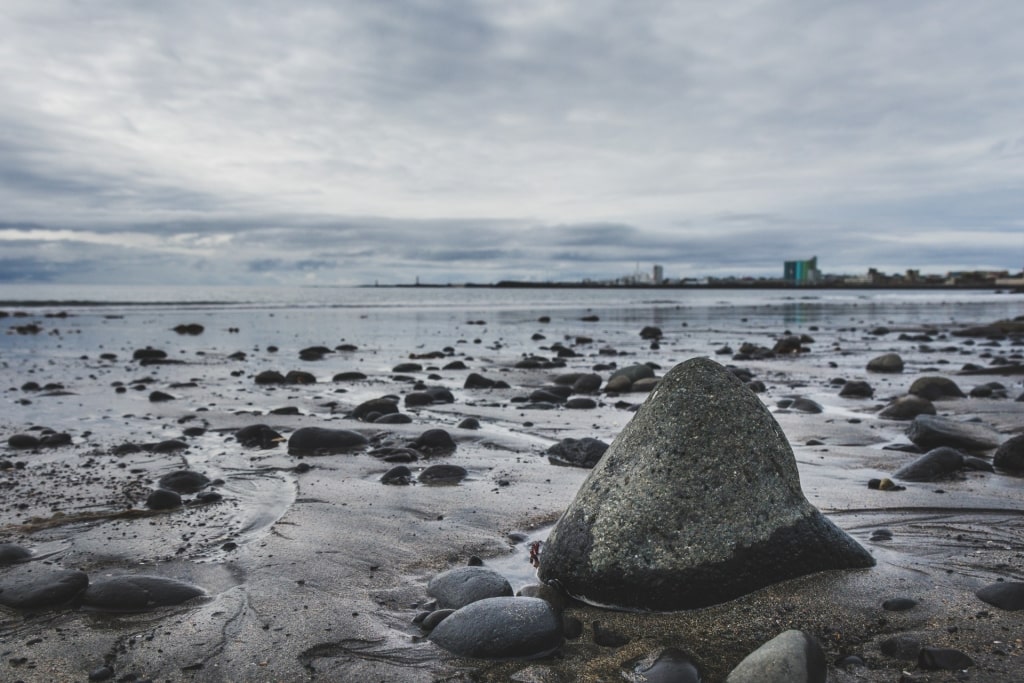
Langisandur Beach, near Reykjavik
This Blue Flag sandy beach on Iceland’s west coast is around a 50-minute drive north of Reykjavik.
The journey here is beautiful, with the highway cutting between sky-piercing mountains and endless ocean vistas.
Pack your bathing suit or roll up your hiking pants to paddle in the water. One of the best things to do on Langisandur Beach is to join locals and in-the-know travelers for a soothing hot soak at Guðlaug Baths, right behind the beach.
If you’ve time to spare, visit the delightful Akranes Folk Museum. The museum traces life in this pocket of Iceland’s west coast, from the 17th century to the present day, through audio storytelling, objects, and photographs.
Solheimasandur Beach
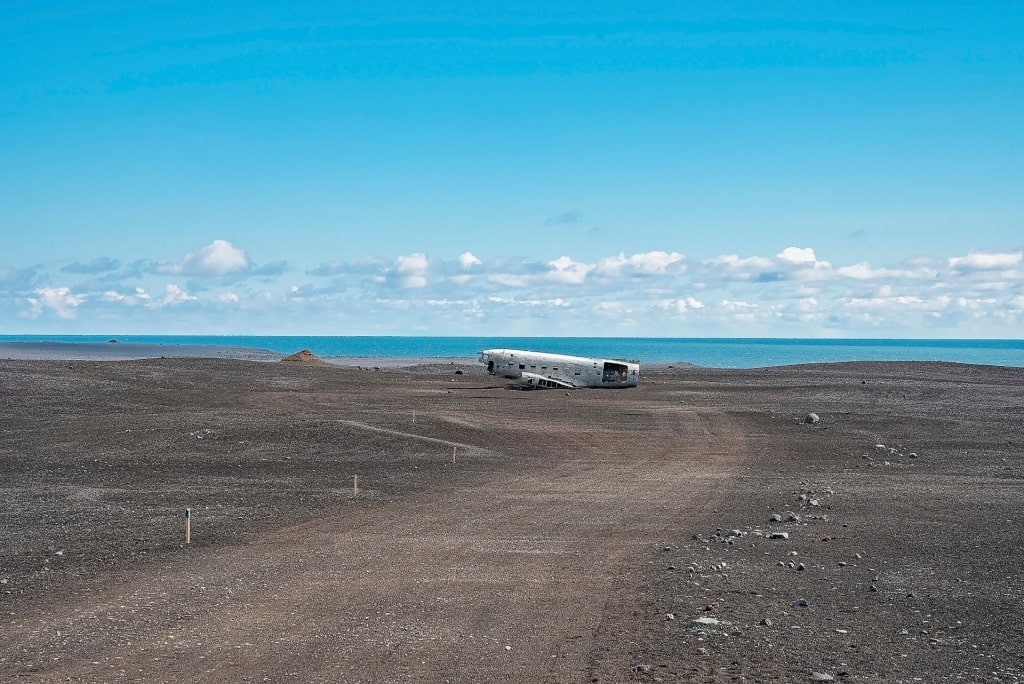
Solheimasandur Beach
Solheimasandur Beach on Iceland’s south coast is famous not just for its inky sand, but as the location of a 1973 plane crash. Thankfully, all passengers aboard the United States Navy DC aircraft survived.
The haunting wreckage can be explored up close on Solheimasandur Beach and makes for striking photographs.
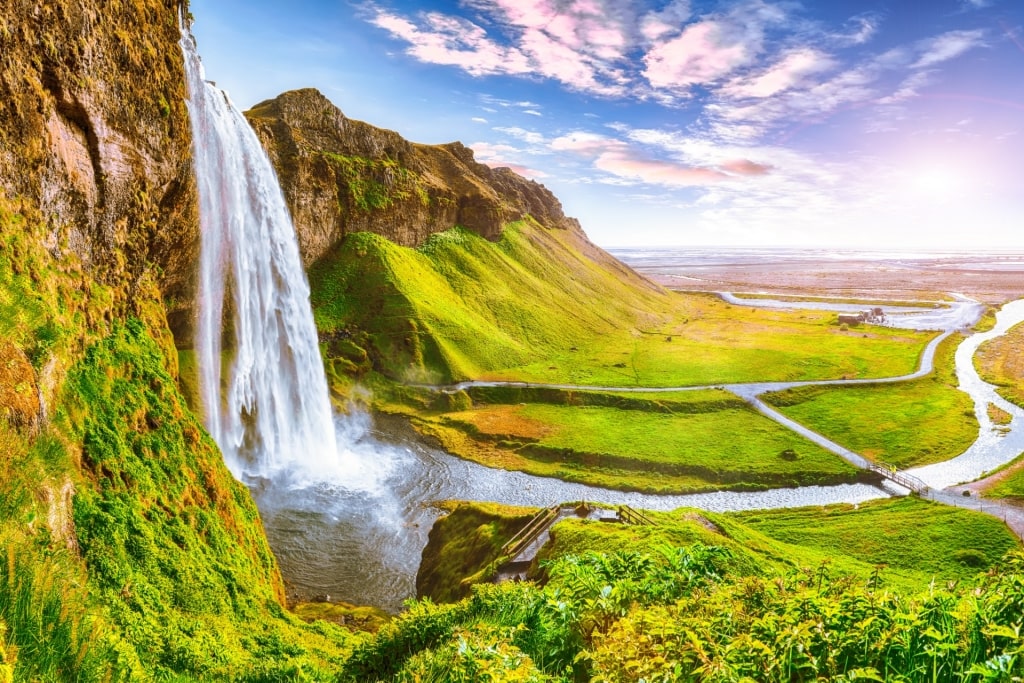
Seljalandsfoss
Sólheimasandur is a short drive from the mighty Seljalandsfoss, one of Iceland’s fantastic cascading waterfalls. Stop by after time spent on Solheimasandur Beach to experience walking behind the 200-foot veil of water.
Walk to Gljufrabui—another beautiful waterfall, just a short walk from Seljalandsfoss—found within a narrow canyon.
Meleyri Beach, near Seydisfjordur
Iceland beaches are typically unspoiled shores with few (if any) amenities, including the faraway Meleyri Beach on the country’s east coast.
This strip of volcanic sand borders Iceland’s ring road near Breiðdalsvík, which means despite its remoteness, it’s fairly easy to reach.
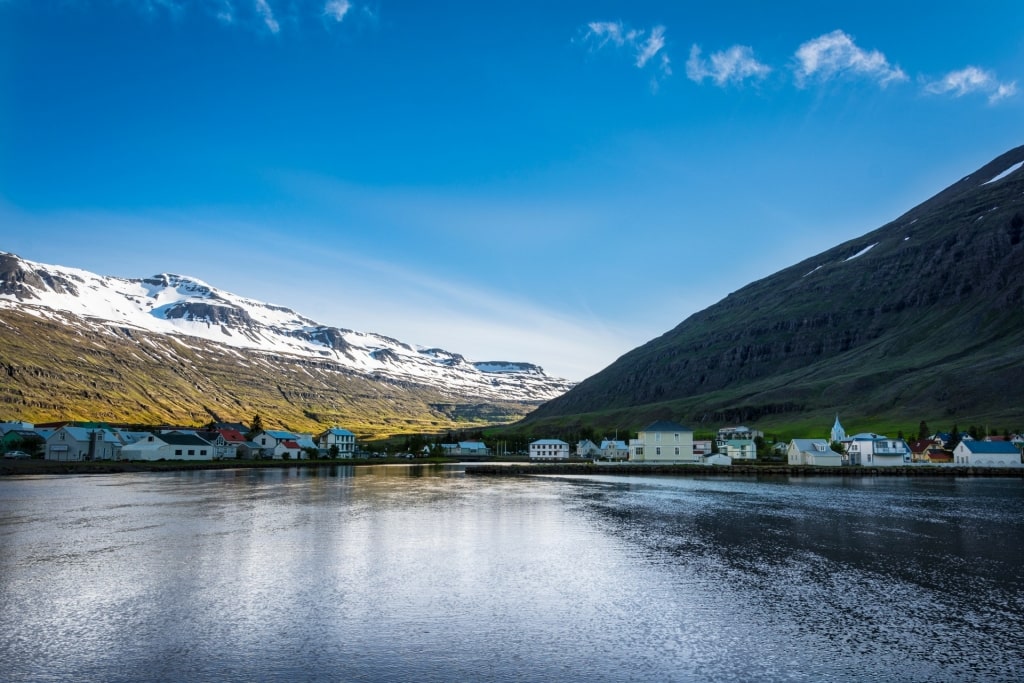
Seydisfjordur
The drive from Seydisfjordur takes travelers through a section of the breathtaking Eastfjords—a 75-mile patch in the country’s northeast—of jagged cliffs, narrow fjords, and quaint fishing villages.
Meleyri is perfect for hiking and experiencing Iceland’s nature. Look out for the region’s wild reindeer roaming freely in the area.
If you’re a fan of craft brews, stop by the tiny town of Breiðdalsvík to visit Beljandi Brewery after a rewarding beach hike and sample the local ales.
Read: Best Breweries in Iceland
Hofsós Beach, near Akureyri

Hofsós Beach, near Akureyri
At 65 degrees north, Hofsós is one of Iceland’s most northerly beaches, lining a small section of the silky Skagafjörður fjord near Akureyri. Hofsós Beach is small, volcanic, and backed by a rising grassy bank.
Walk two minutes from the beach to Staðarbjörg basalt columns, following the steps down to the shore from the road, for serene fjord views.

Hofsós
Hofsós, which is dotted with colorful houses, might be a small fishing village but it has a museum, grocery store, public swimming pool, and a restaurant.
Explore The Emigration Center’s exhibition, which charts the story of Icelanders’ emigration to North America during the 18th century.

Grafarkirkja
Another essential stop when visiting Hofsós Beach is Grafarkirkja, the oldest turf church in Iceland and the stuff of fairytales. The existing church dates to the 17th century, though older churches stood here before.
Grafarkirkja isn’t open for visitors to step inside, but you can freely wander the grounds, including a circular turf wall that protects a small graveyard.
Rauðisandur Beach
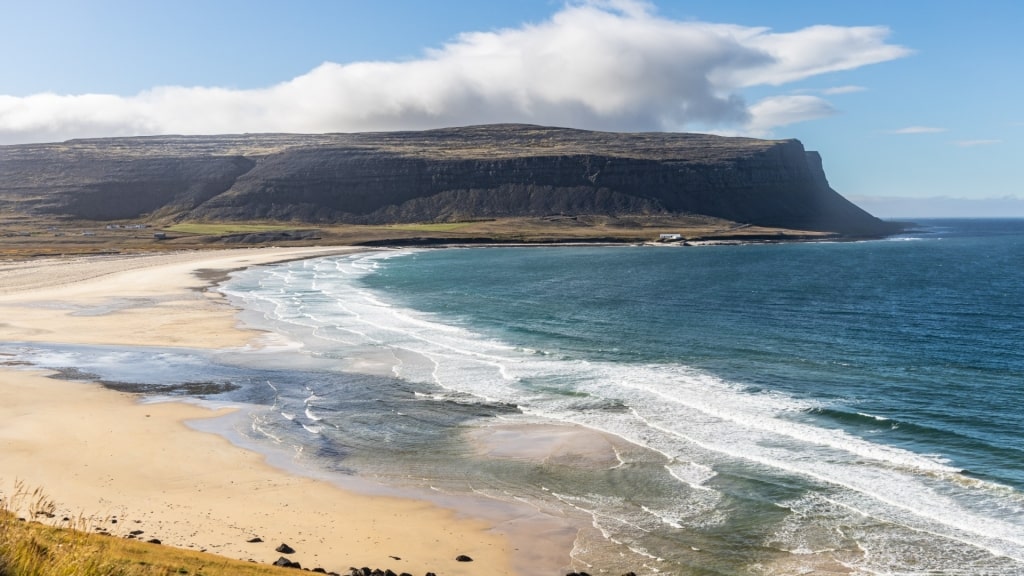
Rauðisandur Beach
Reached in under two and a half hours from Ísafjörður in the Westfjords, Rauðisandur is one of the most dazzling beaches in Iceland; its velvety, ochre-tinged shore earning it the nickname of Red Sands.
Reaching Rauðisandur is an adventure. In addition to the drive, visitors will also need to tackle a short hike from the parking lot.

Puffins
Rauðisandur lies on the same stretch of coastline as Látrabjarg, the tallest bird-watching cliffs in Europe, with watchers from around the world visiting the area to witness the mind-boggling summer turnout.
Gaze out to the ocean and to the ashen cliffs surrounding Rauðisandur to spot passing guillemots, puffins, razorbills, and gulls.
Seals are often spotted in the ocean and resting on the shore. Look carefully and you may even spot the occasional tail-slapping humpback whale or dolphins leaping through the water.
Read: Best Things to Do in Isafjordur
Þingeyri Beach, near Ísafjörður

Þingeyri Beach, near Ísafjörður
The toy town of Þingeyri is framed by the rousing Westfjords Alps and scenic Dýrafjörður fjord. It’s also home to another of Iceland’s black-sand beaches.
Before descending onto the shore, enjoy warming hot drinks at Simbahöllin, the village cafe where Belgian waffles are always on the menu. For a self-guided tour of Þingeyri and its soothing beach, hire a bike from Simbahöllin (the owners also offer horseback riding sessions).
A must-do for water lovers is a thrilling sea kayak tour departing from the beach. Row into the glossy, 20-mile-long fjord, led by a local guide to see seals lounging on the rocks.
Pack your camera in a waterproof case as there are endless photo opportunities to capture wildlife, including seals, migratory birdlife, and even humpback whales during summer.
Sandvik Beach, near Reykjavik
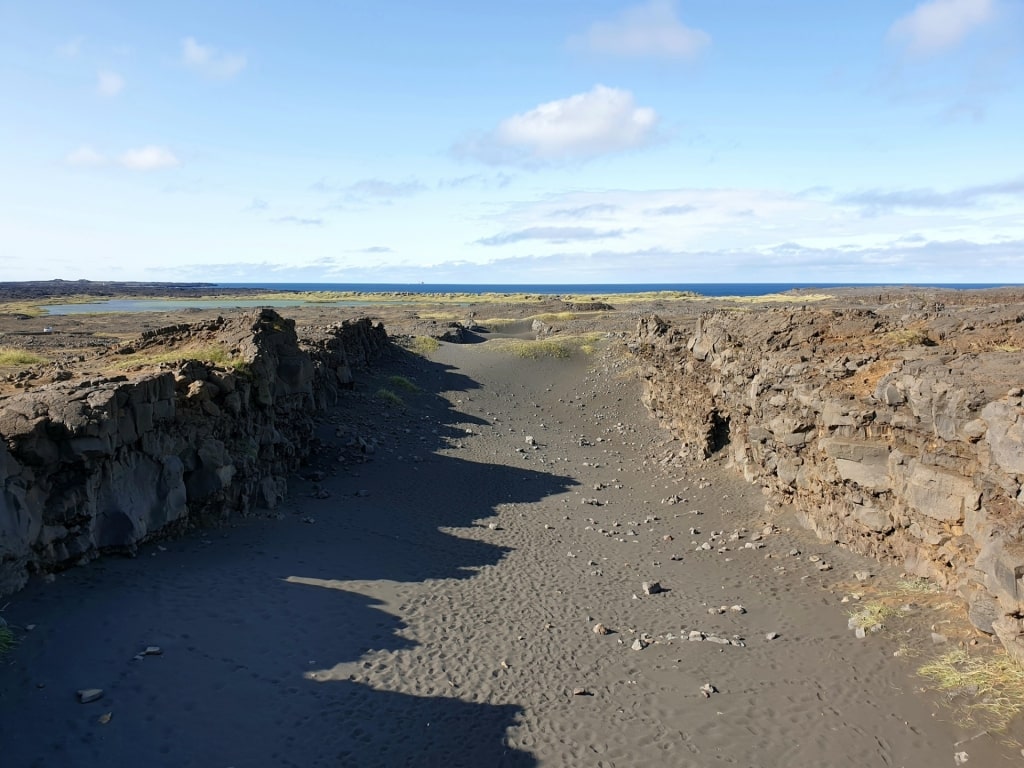
Sandvik Beach, near Reykjavik
This magnificent dark beach—close to Iceland’s Blue Lagoon geothermal spa—lies on the remarkable Reykjanes peninsula, which juts into the North Atlantic Ocean.
Sandvik is a curved beach that’s cradled among the region’s vast, volcanic landscape, with plenty of opportunity for mind-clearing Icelandic hikes.
While the waves are too strong for swimming, you could enjoy a bracing ankle-deep paddle.
At low tide, look out for the wreckage of a ship that ran aground here in 1981.
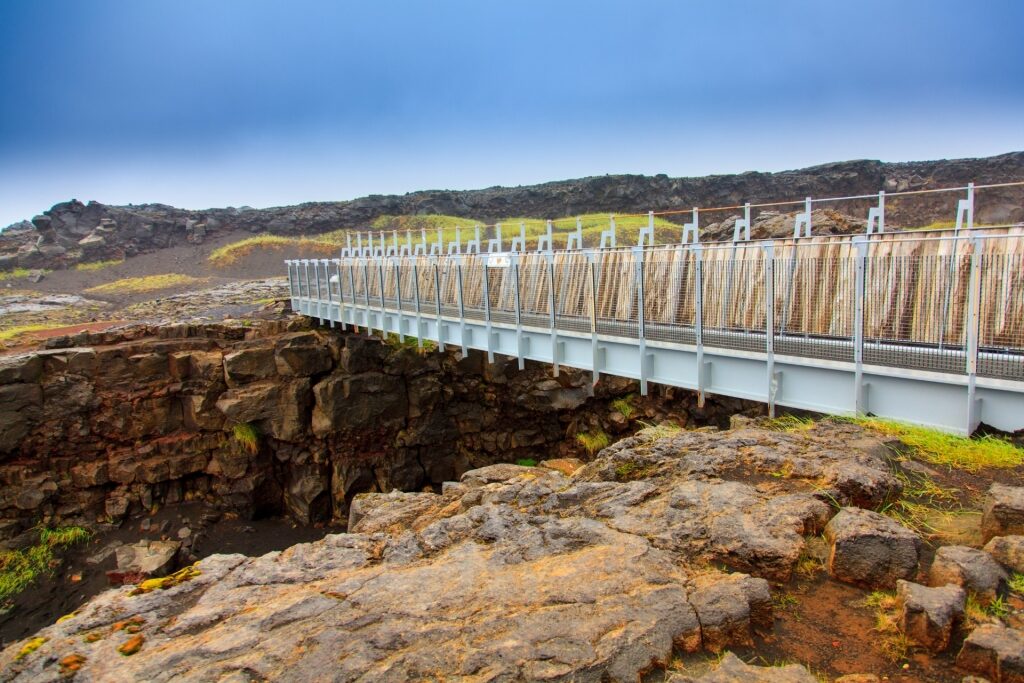
Bridge Between Continents
After, stop by the nearby Bridge Between Continents to cross the symbolic footbridge lying over a large fissure, connecting the Eurasian and North American tectonic plates.
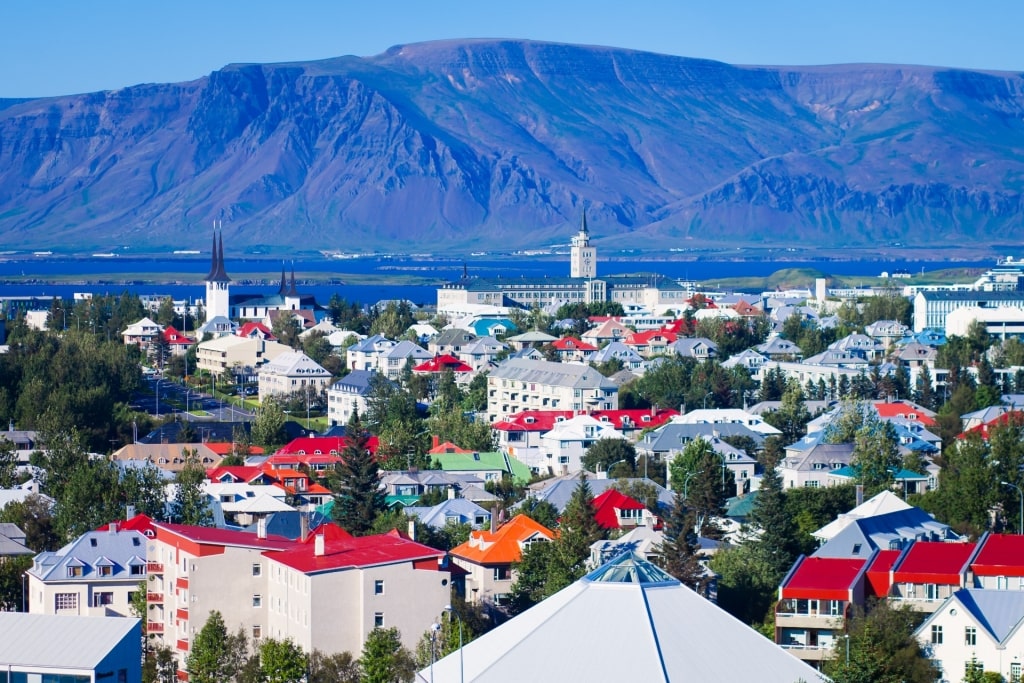
Reykjavik
Iceland’s beaches are as dramatic as the country’s fiery volcanoes, glassy fjords, and blue glaciers. Search Celebrity’s cruises to Iceland and discover this mesmerizing country on your next vacation.
